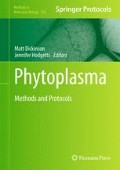Abstract
Phytoplasmas are plant pathogens of huge economic importance due to responsibility for crop yield losses worldwide. Institutions around the world are trying to understand and control this yield loss at a time when food security is high on government agendas. In order to fully understand the mechanisms of phytoplasma infection and spread, more insect vector and phytoplasma colonies will need to be established for research worldwide. Rearing and study of these colonies is essential in the research and development of phytoplasma control measures. This chapter highlights general materials and methods for raising insect vector colonies and maintenance of phytoplasmas. Specific methods of rearing the maize leafhopper and maize bushy stunt phytoplasma and the aster leafhopper and aster yellows phytoplasma strain witches’ broom are also included.
Access this chapter
Tax calculation will be finalised at checkout
Purchases are for personal use only
References
Sugio A et al (2011) Phytoplasma protein effector SAP11 enhances insect vector reproduction by directly manipulating plant development and defense hormone biosynthesis. PNAS USA. doi:10.1073/pnas.1105664108
Murral DJ et al (1996) Effects of temperature and vector age on transmission of two Ohio stains of aster yellows phytoplasma by the aster leafhopper (Homoptera: Cicadellidae). J Econ Entomol 89:1223–1232
Galetto L et al (2009) Variation in vector competency depends on chrysanthemum yellows phytoplasma distribution within Euscelidius variegatus. Entomol Exp Appl 131:200–207
Marzachí C, Bosco D (2005) Relative quantification of chrysanthemum yellows (16Sr I) phytoplasma in its plant and insect host using real-time polymerase chain reaction. Mol Biotechnol 30:117–127
Beanland L et al (2000) Influence of aster yellows phytplasma on the fitness of aster leafhopper (Homoptera: Cicadellidae). Ann Entomol Soc Am 93:271–276
Bressan A et al (2005) Effects of two strains of Flavescence dorée phytoplasma on the survival and fecundity of experimental leafhopper vector Euscelidius variegatus Kirschbaum. J Invertebr Pathol 89:144–149
Malagnini V et al (2010) A study of the effects of ‘Candidatus Phytoplasma mali’ on psyllid Cacopsylla melanoneura (Hemiptera: Psyllidae). J Invertebr Pathol 103:65–67
Tedeschi R, Bosco D, Alma A (2002) Population dynamics of Cacopsylla melanoneura (Homoptera: Psyllidae), a vector of apple proliferation phytoplasma in northwestern Italy. J Econ Entomol 95:544–551
Tedeschi R, Alma A (2004) Transmission of apple proliferation phytoplasma by Cacopsylla melanoneura (Homoptera: Psyllidae). J Econ Entomol 97:8–13
Hughes GL et al (2008) In vitro rearing of Perkinsiella saccharicida and the use of leaf segments to assay Fiji disease virus transmission. Phytopathology 98:810–814
Maramorosch K (1999) Leafhopper and planthopper rearing. In: Maramorosch K, Mahmood F (eds) Maintenance of human, animal, and plant pathogen vectors. Science Publishers, Enfield, pp 199–211
Ammar E-D, Hall DG (2011) A new method for short-term rearing of citrus psyllids (Hemiptera: Psyllidae) and for collecting their honeydew excretions. Fla Entomol 94:340–342
Skelley LH, Hoy MA (2004) A synchronous rearing method for the Asian citrus psyllid and its parasitoids in quarantine. Biol Control 29:14–23
Zhang J et al (2004) Molecular and symptom analyses of phytoplasma strains from lettuce reveal a diverse population. Phytopathology 94:842–849
Ebbert MA, Nault LR (2001) Survival of Dalbulus leafhopper vectors improves after exposure to maize stunting pathogens. Entomol Exp Appl 100:311–324
UK Department of Food and Rural Affairs (2009) Explanatory leaflet on the issue of licences for the import, movement and keeping of prohibited plants, plant material, plant pests, soil and growing medium. http://www.fera.defra.gov.uk/plants/forms/documents/plantHealth/DEF-PHI1-FERA-1.pdf. Accessed 11 Nov 2011
Nault LR, Ammar ED (1989) Leafhopper and planthopper transmission of plant viruses. Annu Rev Entomol 34:503–529
Acknowledgments
I acknowledge Angela Strock (Ohio Agricultural Research and Development Center, Wooster, Ohio State University, OH 44691) and El-Desouky Ammar (Subtropical Insects Research Unit, USDA-ARS, Fort Pierce, FL. 34945) for tuition in maintenance and handling of leafhoppers, and Insectary staff and Dr Saskia Hogenhout (John Innes Centre, Norwich Research Park, Norwich, NR4 7UH, U.K.) for tuition and guidance. The project was funded by a BBSRC studentship.
Author information
Authors and Affiliations
Corresponding author
Editor information
Editors and Affiliations
Rights and permissions
Copyright information
© 2013 Springer Science+Business Media, LLC
About this protocol
Cite this protocol
Kingdom, H. (2013). Insect Maintenance and Transmission. In: Dickinson, M., Hodgetts, J. (eds) Phytoplasma. Methods in Molecular Biology, vol 938. Humana Press, Totowa, NJ. https://doi.org/10.1007/978-1-62703-089-2_5
Download citation
DOI: https://doi.org/10.1007/978-1-62703-089-2_5
Published:
Publisher Name: Humana Press, Totowa, NJ
Print ISBN: 978-1-62703-088-5
Online ISBN: 978-1-62703-089-2
eBook Packages: Springer Protocols

